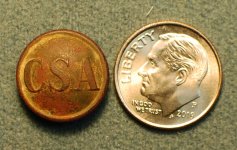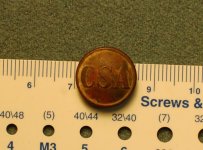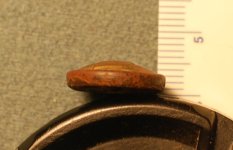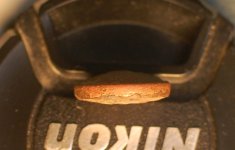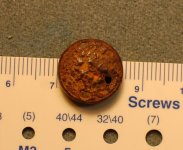ToySoldier
Forum Supporter
Nailfinder85 and I met up for the first time to explore one of his permissions in central KY. Old roads, shoulder high weeds, a creek, bushwacking through woods to an old home site, and finishing up in the yard of an 1800s home.
Nailfinder85 found the back of a two piece button right off the bat and then it got quiet for hours. I was having a great time, but thought I was skunked until I finally hit a few pennies. By that time the 90+ degree heat was beating down and we were swinging and listening for decent signals while making our way back to our vehicles. I hit a small, solid 4 inch deep nickel signal and pulled out a small Confederate States of America button.
The back of the button is a mess, and I went at it with a toothpick to see if there are any markings. Not even a hint. The hole is from corrosion. The blank back...possibly a tin back...suggests it was made locally (in the US) to meet the demand during the war and not by one of the European makers.
The Tice book on civil war buttons gives a few examples but also says too many back variations of stateside manufactured CSA buttons were made to ever illustrate or catalog them all.
As shown in the photo, this one measures just shy of 16mm. Cuff size. I've spent the past few days looking at a lot of examples online, but most of them are coat sized.
Veterans reproductions made after the war were made by Waterbury, so it's possible to find 100+ year old reproductions, but those apparently had clear markings and the details of the letters were slightly different.
Given the location found, depth, and apparent age I can't help but think it's the real deal. Any input (and sources) is appreciated.
Along the way, Nailfinder85 taught me a few things about spotting native tools and I offered a few tips on detecting. But, what can you say to a guy that has been detecting for just over a month, is getting good permissions, and has found 1806 Spanish silver in Kentucky?!
Nailfinder85 found the back of a two piece button right off the bat and then it got quiet for hours. I was having a great time, but thought I was skunked until I finally hit a few pennies. By that time the 90+ degree heat was beating down and we were swinging and listening for decent signals while making our way back to our vehicles. I hit a small, solid 4 inch deep nickel signal and pulled out a small Confederate States of America button.
The back of the button is a mess, and I went at it with a toothpick to see if there are any markings. Not even a hint. The hole is from corrosion. The blank back...possibly a tin back...suggests it was made locally (in the US) to meet the demand during the war and not by one of the European makers.
The Tice book on civil war buttons gives a few examples but also says too many back variations of stateside manufactured CSA buttons were made to ever illustrate or catalog them all.
As shown in the photo, this one measures just shy of 16mm. Cuff size. I've spent the past few days looking at a lot of examples online, but most of them are coat sized.
Veterans reproductions made after the war were made by Waterbury, so it's possible to find 100+ year old reproductions, but those apparently had clear markings and the details of the letters were slightly different.
Given the location found, depth, and apparent age I can't help but think it's the real deal. Any input (and sources) is appreciated.
Along the way, Nailfinder85 taught me a few things about spotting native tools and I offered a few tips on detecting. But, what can you say to a guy that has been detecting for just over a month, is getting good permissions, and has found 1806 Spanish silver in Kentucky?!
Attachments
Last edited:


